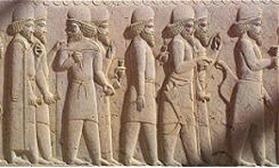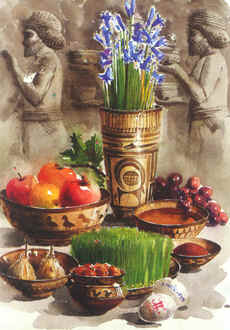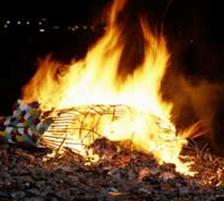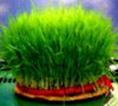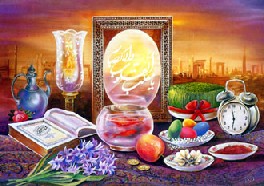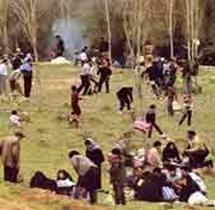|
|
|
History of Nowruz, the Persian New Year
www.mihanam.com Please copy the following message about Nowruz and send it to your
non Persian friends and the media in your town. With your
Nowruz, Persian New Year
In harmony with rebirth of nature, the Persian New Year Celebration, or Nowruz, always begins on the first day of spring, March 20th of each year. Nowruz ceremonies are symbolic representations of two ancient concepts - the End and Rebirth. About 3000 years ago Persian's major religion was Zoroastrianism, named in honor of its founder Zoroaster, and arguably the world's first monotheistic religion. Zoroastrians had a festival called "Farvardgan" which lasted ten days, and took place at the end of the solar year. It appears that this was a festival of sorrow and mourning , signifying the end of life while the festival of Nowruz, at the beginning of spring signified rebirth, and was a time of great joy and celebration. Nowruz was officially acknowledged and named "Nowruz" by mythical Persian emperor, Shah Jamshid, from Achaemenid Dynasty (500 BC).
Ashaemenied created the first major empire in the region and built Persepolis complex (Takhte Jamshid) in the city of Shiraz. Nowruz in Persian means "New Day" and brings hope, peace and prosperity to the world and has been celebrated among people regardless of ethnic background, political views or religion in many countries around the globe such as Iran, Afghanistan, Azerbaijan, Turkey, Uzbekistan, Pakistan, Georgia, Iraq, Tajikistan, Syria ,Armenia and India. Some of the activities during Nowruz are Spring cleaning, buying new cloths, painting eggs, family reunion, giving presents, visiting neighbors and friends and celebrating by having a picnic on the 13th day of Spring. Happy NowRuz!
Persian History
For more than three thousand years Persia was a melting pot of civilizations and demographic movements between Asia and Europe. Under Cyrus the Great, it became the center of the world’s first empire. The country has always been known to its own people as Iran (land of the Aryans) or “noble people”, although for centuries it was referred to as Persia (Pars or Fars) by the Europeans, mainly due to the writings of Greek historians. First inhabited 4000 B.C., the region was overrun by Aryans, who later split into two groups, the Medes and the Persians. The Persian Empire was founded 550 B.C. by Cyrus the Great and dominated the surrounding area until the time of Alexander the Great. Cyrus the Great overthrew the Median rulers, conquered the kingdom of Lydia in 546 BC and established the Persian Empire
Cambyses II son of Cyrus the Great conquered the Egyptians in 525 BC and Darius the Great his successor pushed the Persian borders far as Indus River and constructed a canal connecting the Nile River and the Red Sea. Other well-known Persian Kings were Xerxes, Ardashir, Shapur, Yazdegerd, Firuz, Khosrau. The last of the Sassanid kings was Yazdegerd III, during whose reign (632-41) the Arabs invaded Persia and replaced Zoroastrianism (Persian religion at the time and still practiced by some Persians in Iran and around the globe) with Islam
Nowruz Customs
In harmony with the rebirth of nature, the Iranian New Year Celebration, or Nowruz, always begins on the first day of spring. Nowruz ceremonies are symbolic representations of two ancient concepts - the End and the Rebirth; or Good and Evil. A few weeks before the New Year, Iranians clean and rearrange their homes. They make new clothes, bake pastries and germinate seeds as sign of renewal
Nowruz Customs and Rites
In the past 20 days before Nowruz one could observe a great bustle in every Iranian house. Every body thinksof procuring new dresses and sweetmeats for the Haft Sin table. Before anything else, the family plants sabze which is wheat and pea planted in small and big china bowls and as soon as the grass grows up about 10 cm, they tie the root with colorful laces. During the change to new year, they lay the sabzes around the Haft Sin table. They put ducks and cocks made of wax over the tallest sabze and paint the pictures with green dye. Another rite during Nowruz which started three days before the new year was playing eggs. At each street and alley and house, the elders and children played with eggs and women also participated in the game. The eggs were boiled and painted their crest with beautiful colorful images. To win more eggs some naughty ones manufactured artificial eggs by boring a hole at the bottom and sucking the contents of the egg and filling it with wax which dried and hardened and made the egg resistant. As a result, the experienced players examined the egg before the game to discover a fraud. The women from every class also participated in such games when they visited families they carried the eggs and played with them. Meanwhile at those old times the price of an egg was one Shahi and that of cooked and pointed egg was two Shahis. Usually several hours after the new year people started to visit each other and the visit continued until the 13th day of the new year. On Nowruz holidays the old Persians observed special rites. They cleaned their houses, decorated the biggest chamber of the house with flowers, kindled sandal and wild rue to expel sinful souls from the house, visited each other and prayed. They lighted their houses because they believed that on the night of Nowruz their ancestors would visit them. Of other rites was the kindling of fire, pouring water on each other, and taking ablution at the morning of the new year. Of other rites during Nowruz holidays was presenting gifts, wearing new dresses and eating sweetmeats, planting vegetables, and putting seven herbs on the Haft Sin table which was called Haft Chin or Haft Sheen before the advent of Islam
Spring Cleaning
Iran the custom of welcoming the New Year by making a general house cleaning is also practiced. "Spring clean" is observed days before Norouz with Iranians cleaning every part o the house, dusting furniture and washing carpets. The practice complements the new season and freshness that comes along with spring and New Year. The old Iranian tradition of making houses very clean and spice and span for the New Year celebration is rooted in the belief that the soul of departed family members will come and visit the homes of loved ones on Norouz eve
Haji Firooz
Joyous Forecasters
Mir-e-Norouz, Atash Afrouz and Hadji Firouz, are traditional expressions that herald the joyous coming of Norouz. Hadji Firouz is regarded as the more enduring of the other two New Year announcers.
In return, people gave him gifts or money for the good news that he brought.
is a character who is the traditional herald of the Nowruz. Haji Firooz disguise themselves with makeup and wear brightly colored outfits of satin. Haji Firuz sing and dance and parade as a carnival through the streets with tambourines, kettledrums, and trumpets to spread good cheer and the news of the coming new year Nowruz.
Chahar Shanbeh Soori
Last Wednesday of the year(Chahar Shanbeh Suri) : On the eve of last Wednesday of the year, literally the eve of Red Wednesday or the eve of celebration, bonfires are lit in public places and people leap over the flames, shouting: Give me your beautiful red color And take back my sickly pallor With the help of fire and light symbols of good, we hope to see our way through this unlucky night - the end of the year- to the arrival of springs longer days. Traditionally, it is believed that the living were visited by the spirits of their ancestors on the last day of the year. Many people specially children, wrap themselves in shrouds symbolically reenacting the visits. By the light of the bonfire, they run through the streets banging on pots and pans with spoons called Gashog-Zani to beat out the last unlucky Wednesday of the year, while they knock on doors to ask for treats. Indeed, Halloween is a Celtic variation of this night. In order to make wishes come true, it is customary to prepare special foods and distribute them on this night. Noodle Soup a filled Persian delight, and mixture of seven dried nuts and fruits, pistachios, roasted chic peas, almond, hazelnuts, figs, apricots, and raisins *** happens on the last Tuesday evening of the year. Every family gathers several piles of wood or brush in the streets or parks to be lit shortly after the sunset. Then all the family members line up and take turns jumping over the burning fire and singing “sorkheeyeh toe az man, Zardeeyeh man az toe’. “I give my paleness to the fire and take fire red healthy color”. Yellow or paleness symbolizes the sickness and pain and red symbolizes heath. Fireworks can be heard throughout the night
Fal-Gush This is another ritual in which someone makes a wish and stands at the corner of an intersection , or on a terrace or behind a wall. That person will know his fortune when he overhears conversation of a passerby
Growing Grain Sprouts
The practice of preparing New Year sprouts from wheat
for the New Year's eve "Haft Seen" is an ancient one. Harvesting time was accompanied by the singing and playing of musical instruments on the 6th of Farvardin (March 27) of every year, with joy and happiness evident in each Iranian family gathered around the courtyard.
Growing sprouts in homes for the Norouz has its peculiar
process and is the responsibility of housewives.
Haft Seen
The symbolic dishes consist of: 1. Sabzeh or sprouts, usually wheat or lentil representing
rebirth. To reconfirm all hopes and wishes expressed by the traditional foods, other elements and symbols are also on the sofreh: * a few coins placed on the sofreh represent prosperity
and wealth; On either side of the mirror are two candlesticks holding a flickering candle for each child in the family. The candles represent enlightenment and happiness
Is a spread with seven items which each symbolizes a wish or theme. All seven items in this ceremonial table starts with the Persian letter Seen or S in English. The Haft Seen spread is usually put out a week before the New Year, which sets the mood for celebration. The seven items are Sabzeh (grown wheat or lentil) for rebirth, Samanu (flour and sugar) for sweetness of life, Sekeh (coin ) for prosperity and wealth, Senjed ( dried fruit of Lotus tree) for love, Seer (garlic) for health, Somaq ( sumac berries) for warmth and Serkeh ( vinegar) for patience. Also there other items on the Nowruz spread such as painted eggs, which represent fertility, a mirror that represents image and reflection of life, and a goldfish in a bowl that represents life
With the passing of a year and the coming of another, Iranians get their tables ready with the seven articles that symbolize the triumph of good over evil. The belief dates back to antiquity but the practice is still very much alive. The seven articles usually used are vinegar (serkeh), apple (seeb), garlic (seer), wild olive (senjed), sumac (somaq), juice of germinating wheat or malt mixed with flour and brought to a consistency (Samanu) and a dish of specially raised wheat or other seed spour (Sabzeh). Note that all articles begin with the Persian "s" sound.
A jar of water is sometimes added to symbolize purity and freshness, along with bread, a traditional symbol of a sustainer of life. It is usual to see fresh milk, cheese, fruits, dates and coins on the New Year table. Wild olives and apples are symbols of love and pomegranates are fruits venerated by Iranians. Coins are used to symbolize prosperity and spherical sour oranges represent the earth
The traditional Noruz table called "Sofreh haft-seen" consisted of seven (7) kinds of food each starts with letter "sin" in Persian (Farsi) similar to the letter "s" in English -- symbolizing life, health, wealth, abundance, love, patience, and purity. * Sabzeh, wheat or lentil sprouts represents rebirth. * Samanu, a creamy pudding made from wheat germ is regarded as holy. * Seeb, apple symbolizes health and beauty. * Senjid, the dried fruit of lotus tree for love. * Sir, garlic which is considered medicinal represents health. * Somagh, sumac berries represents the color of sun and the victory of good over evil. * Serkeh, vinegar represents old age and patience
The Arrival of New Year
When the clock strikes New Year all the members of the
family in their clean and new outfits gather around the Norouz table
and Haftseen. The family begins the New Year with a prayer for health,
happiness and prosperity, usually along these lines: "O Reformer
of hearts and minds, Director of day and night and Transformer of conditions,
change ours to the best in accordance with Your will."
Seezdah Bedar
The two weeks long Nowruz celebration ends with SeezDeh Bedar. SeezDeh means Thirteen and SeezDeh Bedar is the process of getting over with or passing over the thirteenth day of the New Year This day is usually celebrated outdoor in a picnic style. This is the last day of New Year celebration and life will return to normal the following day Schools will open, shops will start on their regular hours and offices and Government agencies are back in normal operation. So, this is the last chance to spend some time with family and friends and enjoy the fresh smell of Spring.On this day, girls & boys tie a knot with grass and make wishes perhaps for a husband or wife. When the knot is opened (it is beleived that) their luck will open and their wishes will come true. Newly weds also tie a grass knot making wishes for a baby, a house, or whatever is on their Have-To-Have list is the 13th day of Nowruz and Persians to overcome the bad luck they spend the entire day out of the house with families and friends in the parks having a picnic. They sing and play games and celebrate a happy and healthy holiday season and end the holiday season on a positive note |
 help,
we can send the message of Nowruz which is hope, peace and prosperity
to everyone in the world and make Nowruz an International
help,
we can send the message of Nowruz which is hope, peace and prosperity
to everyone in the world and make Nowruz an International  event.
Would you please join us. Also, please print and hand over or fax
to your non iranian friends.
event.
Would you please join us. Also, please print and hand over or fax
to your non iranian friends.